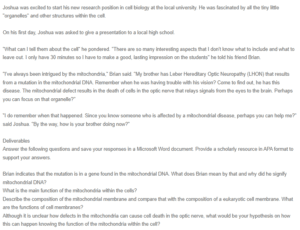Case Study – The Mitochondrion
Essentially, Brian means that Leber hereditary optic neuropathy (LHON) results from an alteration in the mitochondrial DNA (mtDNA). Indeed, LHON is an inherited optic neuropathy that results from mtDNA point mutations that affect respiratory chain complex I genes (Shemesh et al., 2022). He signified mtDNA for several reasons. First, mitochondria are unique organelles because they contain their own DNA molecules, mitochondrial DNA, which are distinct from the nuclear genome. mtDNA is small and circular and thus resembles bacterial DNA and differs from the linear DNA in the nucleus (Saladin, 2021). Second, mtDNA replication occurs independently of the cell cycle. Another significant feature of mtDNA is maternal inheritance; it can only be inherited through the mother, whereby the paternal mtDNA is eliminated during fertilization. Additionally, except for random mutation, mtDNA often remains unchanged. As such, mtDNA mutations can cause rare hereditary diseases like LHON.
Mitochondria are primarily specialized for ATP (adenosine triphosphate) synthesis and are often called the “powerhouses” of the cell. With the help of enzymes located in the cristae, energy is extracted from organic compounds and transferred to adenosine triphosphate (Saladin, 2021).
Mitochondria comprise two membranes: the inner membrane and the outer membrane. The outer membrane is generally permeable and smooth. It harbors molecules involved in mitochondrial fusion and fission and various proteins, such as translocases, and is hence important for the organelle’s physiology (Giacomello et al., 2020). Conversely, the inner membrane is impermeable and has foldings called cristae. The cristae contain metabolites, solutes, and proteins (like cytochrome c), making them the principal site of oxidative phosphorylation. On the other hand, the eukaryotic cell membrane, also called the plasma membrane, is a phospholipid bilayer. It contains proteins, lipids, and cholesterol. The main functions of cell membranes include defining the cell’s boundaries, governing cellular interactions with other cells, and controlling the entry and exit of materials across the cell (Saladin, 2021).
The optic nerve is a sensory nerve specialized for vision. It is highly sensitive to energy deficits and oxidative stress; therefore, defective mitochondria may fail to synthesize ATP as required, compromising the energy supply and resulting in apoptosis of optic nerve cells, thereby causing cell death in the optic nerve.
References
Giacomello, M., Pyakurel, A., Glytsou, C., & Scorrano, L. (2020). The cell biology of mitochondrial membrane dynamics. Nature Reviews Molecular Cell Biology, 21(4), 204–224. https://doi.org/10.1038/s41580-020-0210-7
Saladin, K. (2021). Anatomy & physiology: The unity of form and function (9th ed.). McGraw-Hill Education.
Shemesh, A., Sood, G., & Margolin, E. (2022, September 24). Leber hereditary optic neuropathy (LHON). StatPearls – NCBI Bookshelf. https://www.ncbi.nlm.nih.gov/books/NBK482499/
ORDER A PLAGIARISM-FREE PAPER HERE
We’ll write everything from scratch
Question 
Joshua was excited to start his new research position in cell biology at the local university. He was fascinated by all the tiny little “organelles” and other structures within the cell.

Case Study – The Mitochondrion
On his first day, Joshua was asked to give a presentation to a local high school.
“What can I tell them about the cell” he pondered. “There are so many interesting aspects that I don’t know what to include and what to leave out. I only have 30 minutes so I have to make a good, lasting impression on the students” he told his friend Brian.
“I’ve always been intrigued by the mitochondria,” Brian said. “My brother has Leber Hereditary Optic Neuropathy (LHON) that results from a mutation in the mitochondrial DNA. Remember when he was having trouble with his vision? Come to find out, he has this disease. The mitochondrial defect results in the death of cells in the optic nerve that relays signals from the eyes to the brain. Perhaps you can focus on that organelle?”
“I do remember when that happened. Since you know someone who is affected by a mitochondrial disease, perhaps you can help me?” said Joshua. “By the way, how is your brother doing now?”
Deliverables
Answer the following questions and save your responses in a Microsoft Word document. Provide a scholarly resource in APA format to support your answers.
Brian indicates that the mutation is in a gene found in the mitochondrial DNA. What does Brian mean by that and why did he signify mitochondrial DNA?
What is the main function of the mitochondria within the cells?
Describe the composition of the mitochondrial membrane and compare that with the composition of a eukaryotic cell membrane. What are the functions of cell membranes?
Although it is unclear how defects in the mitochondria can cause cell death in the optic nerve, what would be your hypothesis on how this can happen knowing the function of the mitochondria within the cell?